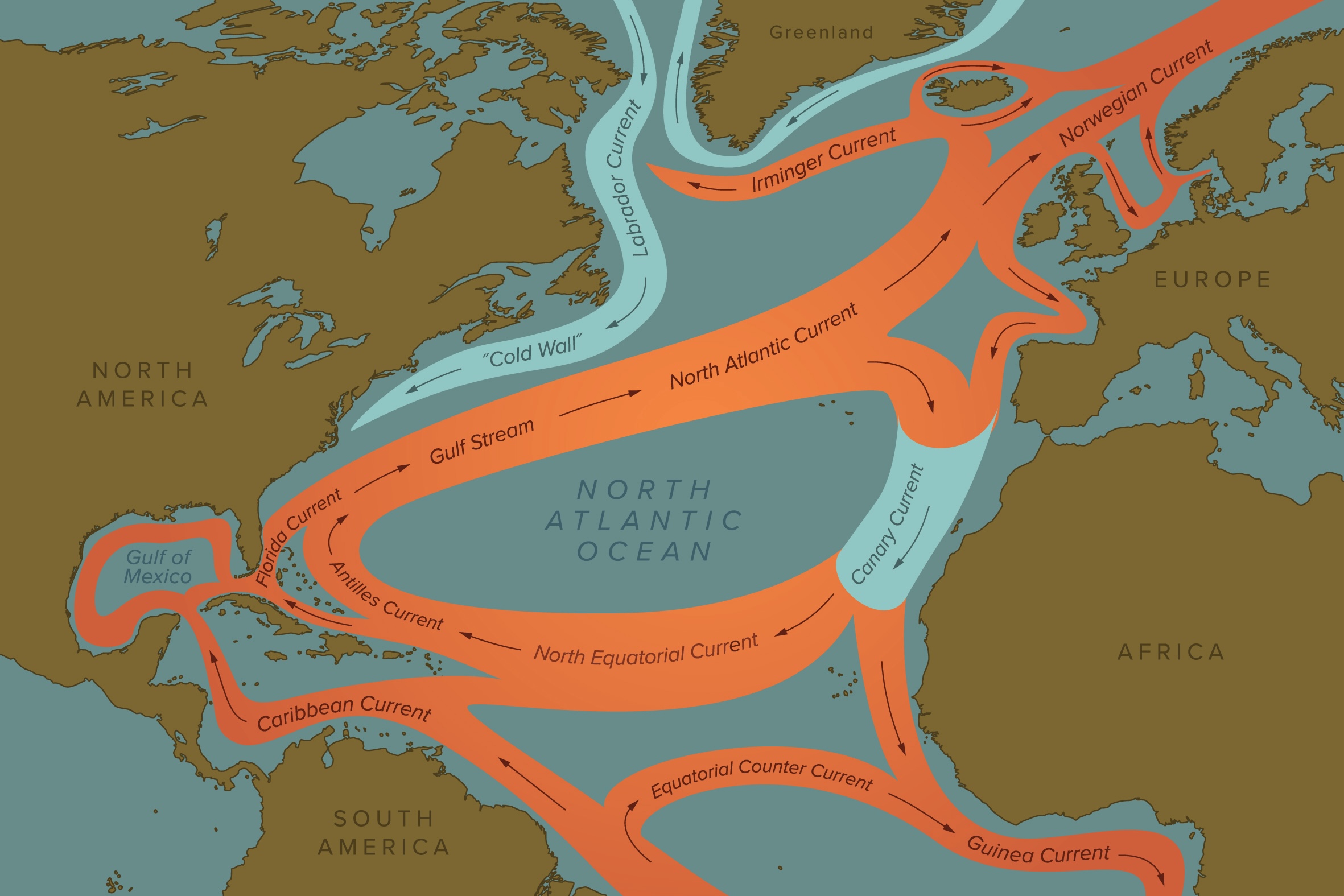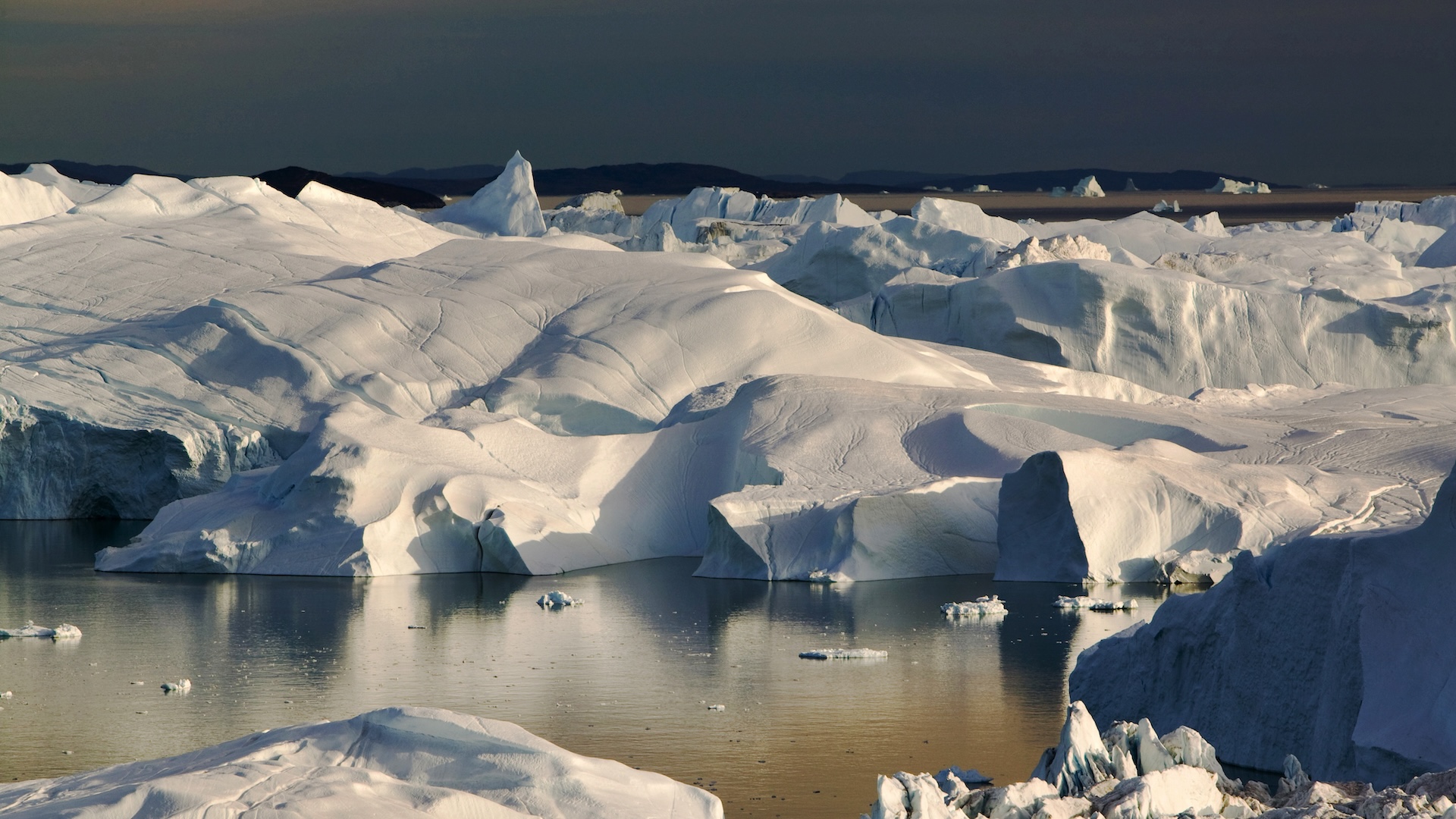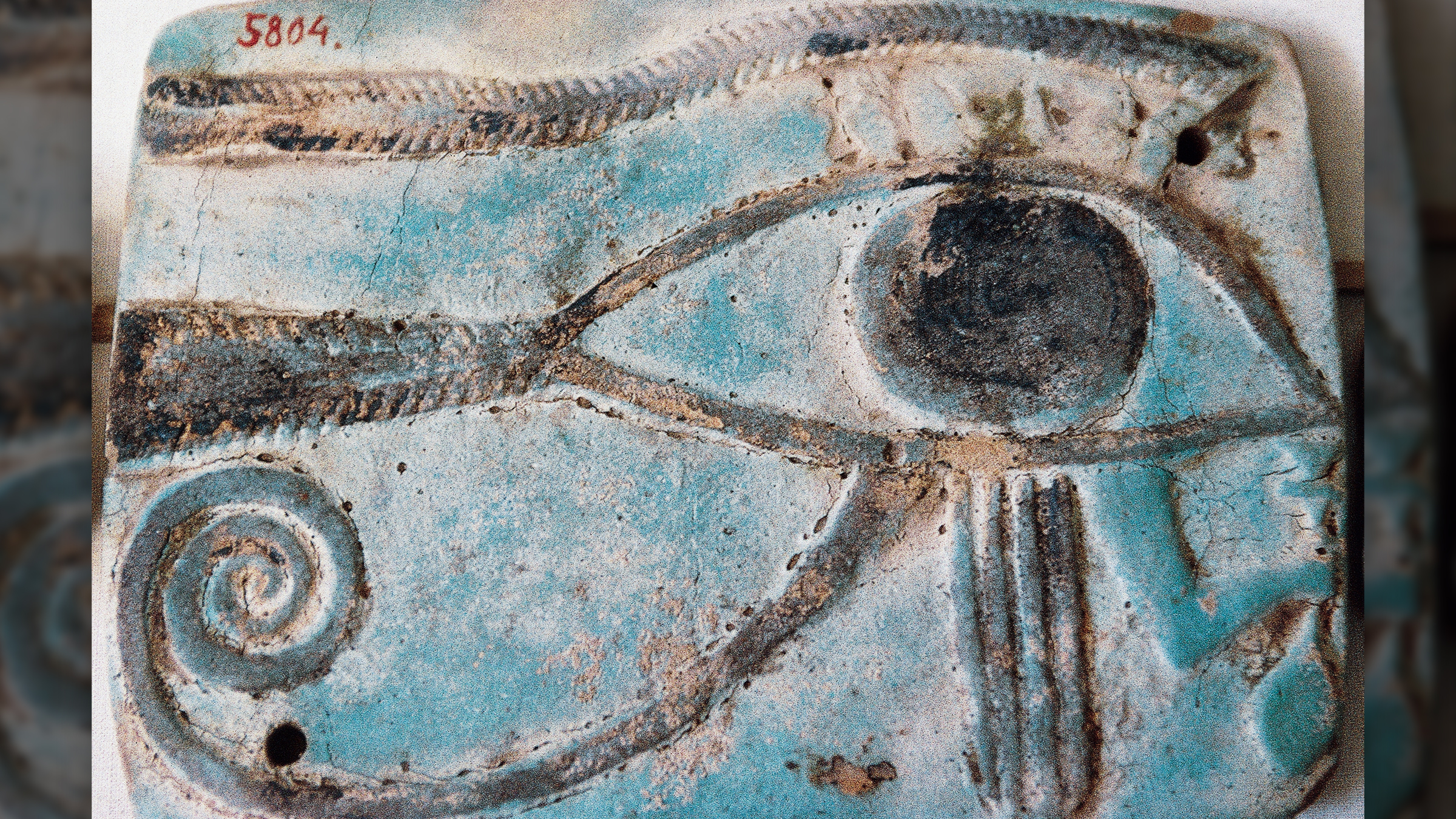
Atlantic ocean currents are weakening — and it could make the climate in some regions unrecognizable
A warm blob of water in the North Atlantic is an ominous sign that a system of currents that regulate the planet's climate could be weakening.

A mysterious patch of water in the North Atlantic has baffled scientists for decades. Located to the southeast of Greenland, this blob of seawater was colder between 1901 and 2021 than during the late 1800s, even as the seas around it became ever warmer.
Some scientists linked this "warming hole" to an inflow of frigid Arctic meltwater; others blamed pollution from shipping, which can bounce the sun's rays back into space. But a growing body of evidence suggests the hole has a more sinister origin — one whose impacts, if unleashed, would reach much farther than a small region of the North Atlantic.
The warming hole might be a sign that Atlantic Ocean currents are slowing down. This network of currents regulates Earth's climate, moving heat from the tropics to the Northern Hemisphere. The currents, which include the Gulf Stream, form a huge and seemingly permanent loop known as the Atlantic Meridional Overturning Circulation (AMOC).

The AMOC has weakened before, ancient sediments reveal, and some past changes in circulation have been extremely abrupt. But human societies will struggle to adapt to the rapid rate of change that many researchers predict over the coming century, said Robert Marsh, a professor of oceanography and climate at the University of Southampton in the U.K. Weaker currents could unleash freezing weather in parts of Europe, exacerbate sea level rise along the U.S. East Coast, and trigger droughts around the equator in ways that scientists are racing to predict.
Whether the AMOC has already weakened and whether the currents could collapse completely are contentious questions. But what is clear is that "we're interrupting the system," Marsh told Live Science.
A giant heater
The AMOC is part of Earth's biggest conveyor belt, the thermohaline circulation, which pushes water around the world's oceans. Waters flowing north from the tip of South Africa ride on the surface of the ocean, absorbing heat from the atmosphere as they glide through the tropics and subtropics. They release this heat into the North Atlantic near Greenland, leading to a warming effect that is particularly strong in Northwest Europe.
"Right now, the Northern Hemisphere is warmer than it would be" if the currents that make up the AMOC were weaker, Maya Ben-Yami, an early-stage researcher who specializes in climate tipping points at the Technical University of Munich, told Live Science. For instance, the AMOC makes air temperatures in countries like Norway 18 to 27 degrees Fahrenheit (10 to 15 degrees Celsius) warmer, on average, than they would be otherwise.
Sign up for the Live Science daily newsletter now
Get the world’s most fascinating discoveries delivered straight to your inbox.
To travel back south, surface waters in the North Atlantic must plunge down the water column and merge with bottom currents. Climate scientists say this sinking step is where the circulation is slowing down, because surface waters have to be very salty, and therefore very dense, to sink. But growing rivers of meltwater from the Greenland Ice Sheet and the Arctic are diluting the salt concentrations of surface waters, preventing them from plunging to the seafloor.

The warming hole that worries scientists is in a spot where the AMOC releases heat. Ocean temperatures there are lower than researchers would expect to see, given current global temperatures, if the AMOC were still going strong. That suggests heat transport from south to north has already declined.
And with climate change cooking the planet, there is a risk that more fresh water will pour into the North Atlantic, triggering a feedback loop that would accelerate the weakening of the AMOC. As ocean currents slow, the amount of salt reaching the North Atlantic may decrease, making it harder for already-diluted surface waters to sink.
"When you have a strong AMOC, it draws in salty water," David Thornalley, an ocean and climate scientist at University College London, told Live Science. "If you start to weaken the AMOC, less salty water gets drawn into the North Atlantic, and that then weakens the AMOC, and then it's a runaway process."
Defining "collapse"
The warming hole is one piece of evidence suggesting the AMOC has already weakened, but not everyone agrees.
The problem is that direct measurements of the AMOC's strength only go back to 2004, so researchers rely on indirect "fingerprints" — climate parameters they think are linked to the AMOC — to identify long-term trends in Atlantic circulation.
The trouble with fingerprints is that they give variable — and sometimes contradictory — results. For instance, a 2018 study suggested weakening, while research published in January suggests Atlantic currents have not declined over the past 60 years, though some scientists criticized the January study's data.
Regardless of whether Atlantic currents have already slowed, most scientists think they will in the future.

Should the circulation weaken significantly, "some pretty major changes are going to happen," Thornalley said, "and they're going to happen gradually over the 21st century."
For one, dwindling ocean currents will carry less heat to countries like Norway, Sweden and the U.K., leading to cooler temperatures in these regions. The amount of cooling will depend on how much strength the AMOC loses.
Climate models generate varying predictions, depending on what assumptions are baked into them, how sensitive they are to certain climate factors, and the data researchers feed the models. Some show a 10% reduction in the AMOC's strength, while others predict a decline closer to 50%, Marsh said.
"A 50% reduction would be far more substantial of an impact on our regional climate," Marsh said, adding that the resulting drop in temperature would disrupt industries that depend on the weather, such as farming. By comparison, "A 10% weakening of the AMOC would be noticeable, but manageable," he said. "It probably would make our weather a little less mild in the wintertime, in particular."
A complete collapse is unlikely, a study published in February found. Even if surface waters stop plunging in the North Atlantic, there are relatively constant factors, such as the wind, that drive the movement of water, Marsh said.
"A collapse, which is some hypothetical 100% failure of the [AMOC], just doesn't feel plausible to me," Marsh said. But the AMOC doesn't need to collapse to throw human lives and systems into chaos, he added.
"Really wild things"
Cooling in the North Atlantic and Northwest Europe could offset some of the warming from climate change — but that may not be a good thing, Marsh said. A drop in temperatures may alter atmospheric processes that drive storms and other weather events in these regions, he said.
Cooling in the North Atlantic won't directly make the U.S. East Coast colder, Marsh said. That's because weather in the Northeast is dictated more by the Arctic polar vortex, a ring of cold wind that circles the North Pole and traps frigid air near the Arctic. If this band becomes deformed or expands, which it sometimes does in the winter, chilly air escapes and sweeps over the Midwest and as far south as the Gulf.
But a weaker AMOC could alter the Arctic polar vortex, which would, in turn, affect the Northeast, Marsh said. The vortex is vulnerable to changes in climate, and recent evidence suggests the structure is already behaving strangely.
Direct impacts on the East Coast and Northwest Europe could also result from sea level rise. Sea levels in parts of the North Atlantic are currently 2.3 feet (70 centimeters) lower than they would be if the AMOC were weaker, because strong currents create uneven sea levels. If the AMOC weakens, water may redistribute itself and add to the sea level rise caused directly by global warming.

As the Northern Hemisphere cools, tropical and subtropical regions could also be thrown into chaos. Studies indicate that a colder North Atlantic would alter Earth's energy balance and trigger a southward shift of the Intertropical Convergence Zone (ITCZ), a band of clouds that encircles the globe near the equator.
The moisture-laden ITCZ bobs up and down depending on Earth's position relative to the sun, bringing heavy rainfall and storms. It is responsible for monsoons — weather patterns with distinct wet and dry seasons — in South America, West Africa, India and East Asia.
Should the ITCZ shift southward, research suggests it would throw monsoons out of whack for at least 100 years. "Right now, we have these regions that are used to getting this very intense rainfall in their wet seasons," said Ben-Yami, the lead author of this research. Ecosystems are adapted to these downpours, and people depend on rainfall for agriculture, she said.
A southward shift of the ITCZ would lead to shorter and drier wet seasons in places like West Africa. These effects could persist for decades and severely disrupt life around the equator, Ben-Yami said. "Farmers somewhere in sub-Saharan Africa, they need that rainfall," she said.
Shifts in rainfall would affect the Amazon rainforest, too. The effects may differ between the Northern and Southern parts, because the rainforest is so big that the southern part would still receive significant rainfall even if the ITCZ were to shift southward, Ben-Yami said.
But the northern Amazon rainforest — including parts of Colombia, Peru, Ecuador, Venezuela, Suriname, Guyana, French Guiana and Brazil — would experience longer and more intense dry seasons, which would be devastating for the region, she said.
Combined, the effects of a weakened AMOC could cost hundreds of billions, if not trillions, of dollars, Thornalley said. "It's a pretty global shift in climate — it would be very, very expensive," Thornalley told Live Science.
What's more, North Atlantic sediments from the last ice age (120,000 to 11,500 years ago) suggest that abrupt shifts in climate linked to the AMOC have occurred in the past.
"We know the climate can do really wild things," Thornalley said. "We know that really, really, really well."
Making predictions
Researchers say the AMOC will weaken significantly before 2100, but pinpointing exactly when the biggest change will happen is tricky.
Because direct measurements go back only 20 years, scientists often extrapolate from historical data to estimate when Atlantic currents might reach a tipping point. Tipping points are thresholds in some of Earth's systems that, once exceeded, can flip these systems from one stable state into a profoundly different one.
A good analogy to explain tipping points is a chair, Ben-Yami said. A chair is stable when it is standing on four legs or lying down; any position between these two is unstable. A person sitting on the chair can tip it backward slightly, but past a certain threshold, the chair tumbles to the ground.
An attention-grabbing study in 2023 concluded that the AMOC could reach a tipping point as early as this year. The authors used sea surface temperatures in the North Atlantic subpolar gyre between 1870 and 2020 to calculate fluctuations in the AMOC's resilience and strength. Their model suggested Atlantic currents are growing less resilient and weaker, to the point of possibly tipping before mid-century.
In a 2024 paper, however, Ben-Yami and other experts argued that there is too much uncertainty in data from before 2004 to predict when the AMOC might tip. "Once you take all these uncertainties into account, you don't get a practical prediction," she said.
"We're getting more and more worried."
UU Research Portal E.J.V. (Emma) Smolders, Utrecht University
Not having robust predictions is perhaps worse than knowing when the system will fail, because the future is so unclear, Ben-Yami said. "We should be even more careful" in the face of this uncertainty, she cautioned.
While some researchers are looking to the past for answers, others are searching for early warning signals that hold clues about future changes in the AMOC. One of these signals is the amount of fresh water flowing into the Atlantic at a latitude of 34 degrees south, near the tip of South Africa. Models suggest fresh water transport there will hit a minimum about 25 years before the AMOC reaches a tipping point, meaning experts could accurately predict shifts in the AMOC before the biggest changes occur.
But knowing about this minimum won't help anyone prevent the AMOC from weakening significantly, because it will be too late to reverse the driver — human-caused climate change — by the time the minimum is reached, said E.J.V. (Emma) Smolders, a doctoral student who specializes in AMOC early warning signals at Utrecht University in the Netherlands.
"We're getting more and more worried," Smolders told Live Science, adding that her research group is trying to find other warning signals that will help scientists make predictions with more lead time to act.
Her group described one of these alternative signals in a study published to the preprint database arXiv in June 2024. The study, which has not been peer-reviewed yet, found that salinity in the Atlantic near the tip of South Africa may be a better indicator than fresh water of when the AMOC will weaken.
Based on patterns in this salt transport, Smolders and colleagues estimated that the AMOC will "collapse" around 2050, which agrees with previous, peer-reviewed research.
Looking for early warning signals is important, because "it could be that we need as much advanced knowledge as possible to prepare civilian, even military, assets" to deal with the consequences of AMOC weakening, Marsh said. These assets may be needed to shield infrastructure and communities from unpredictable weather, he said.
Ultimately, regardless of whether we know exactly when the AMOC will decline, the takeaway is the same, Marsh and others said: Stop global warming by slashing the amount of carbon dioxide emitted into the atmosphere.
The possibility that the AMOC could be approaching a tipping point "should be enough incentive, alongside knowing what the impact would be, for us to want to stop what we're doing," Thornalley said. "We might not be able to say exactly how long we've got left, but [the evidence] suggests we could have a tipping point, and we really want to avoid that."
This story is part of The 89 Percent Project, an initiative of the global journalism collaboration Covering Climate Now.

Sascha is a U.K.-based staff writer at Live Science. She holds a bachelor’s degree in biology from the University of Southampton in England and a master’s degree in science communication from Imperial College London. Her work has appeared in The Guardian and the health website Zoe. Besides writing, she enjoys playing tennis, bread-making and browsing second-hand shops for hidden gems.










